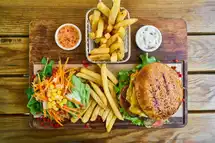What are restaurant trends ?
Restaurant trends are the new innovations and technologies that define the industry. These include food served, dining experiences, delivery techniques and so on.
6 Restaurant Trends That Will Redefine the Food and Beverage Industry in 2023
Why Restaurant Trends Matter

In 2018, McDonald's spent several weeks testing a new technology in its US Market. This product by the tech company Dynamic Yield, that McDonald's would ultimately acquire in 2019, and sell to Mastercard in 2022 would help the fast-food giant enhance customer experience in a significant way.
With its outdoor digital drive thru menu displays, Dynamic Yield's technology showed customers menu options based on day, weather, current restaurant traffic and trending menu items. It even recommended add-ons based on the customer's current selection. On the whole, it offered them a more personalized experience.
Not long after this deal, the world was hit by the Covid pandemic.
It was a scenario no one anticipated. Widespread closures, restricted movement and lockdowns spelled disaster for the food and dining industry, with limited, to no indoor dining. Most full service restaurants had to rely solely on take-out and delivery to stay in business. Revenues in the US market alone declined by 85% in 2020.
What helped businesses survive (the ones that did), was quick adaption to timely technologies and emergent trends. McDonald's, for instance, used its full arsenal of technology-led solutions to help it tide over the pandemic -- from its user-friendly mobile app that helped customers place orders quickly and remotely, to mobile payment options, and contactless drive-thru ordering. This could be one of the reasons that the company exceeded $10 billion, or nearly 20%, in digital sales in 2020, across its top six markets.
Many restaurants, however, were slow to move. They took time to grow their capabilities and adopt evolving innovations. Larger restaurant chains had the infrastructure and deep pockets to implement new trends and technology. But smaller quick service and fast casual businesses lacked the digital tools to face the crisis.
However, what would have been a choice before 2020, has now became a necessity, with the pandemic accelerating the use of technology across businesses, no matter their size. Even for those restaurants that only catered to dine-in customers, an increased digital presence has become the only way to survive.
In 2022, the pandemic may be on the ebb, but other crises continue to loom up, including geopolitical conflicts, tighter federal regulations, and supply chain challenges. The ability to innovate and keep up with new trends will help the restaurant industry tackle these difficulties, and grow their market at the same time.
Restaurantslife takes a look at some of the technologies and food service trends that will define the industry in the near future.
Automated Ordering Expected To Go A Step Ahead

Foodservice operators have traditionally attempted to cater to their customers better by sizing them up -- taking in their age, cultural background and even their economic status. Advanced technology is now doing this for them. The food delivery app GrubHub, for example, has analyzed thousands of dishes and data points to create a personalized recommendation system for its users.
In the physical world, restaurant self-service kiosks are being fitted with cameras to show diners dishes that are likely to appeal to them. Raydiant, a digital signage company is deploying automated technology at its self-ordering kiosks using Sightcorp software. These camera-equipped kiosks can detect a customer's age, mood, and attention level to propose appropriate menu items to them.
Many restaurants are leveraging artificial intelligence (AI) systems to recommend food to customers ordering at their drive-throughs. McDonald's, for one, is set to adopt voice-activated machines that will let customers simply vocalize their orders.
Then there's Burger King -- roughly half its digital menu boards use Deep Flame AI technology to promote popular items in the area on a given day. It also uses external factors such as the weather to highlight items, like pushing iced coffee on a hot day. Restaurant Brands International, which owns Popeye's, Tim Hortons and Burger King, announced that it plans to install "predictive selling" at 10,000 drive-thrus to match menu displays with previous orders based on loyalty account information.
The restaurant industry is in a state of flux, with new technologies and trends emerging constantly.
If you want to stay ahead of the competition, you need to be aware of the latest trends in the food and beverage industry.
Robots In The Kitchen Are Cooking Up A Storm

In addition to deploying self-service kiosks for ordering, automation is taking over the kitchen too. Domino's is testing driverless pizza-delivery vehicles, while KFC is attempting to develop chicken-cooking bots. Accelerated by the pandemic, automated kitchens are being billed as the next big thing in the restaurant industry. A robotic arm to flip pizzas or robots to ascertain accurate measurement of ingredients -- automation behind kitchen counters has resolved the biggest challenge faced by the food industry- the standardization of taste, temperature and quality.
In August 2021, Los Angeles-based salad chain Sweetgreen acquired Spyce. Founded in 2015, this Boston-based startup made waves as a spinout of MIT's mechanical engineering department, where its students developed robots to serve food at the school's dining hall. Now, Sweetgreen is slowly incorporating robotic technology at its stores with the aim of making meal preparation consistent. In May, Sweetgreen announced its first pickup-only location in Washington DC (likely to open in August 2022). It has no dine-in seating, features a hidden production area, and offers only pickup and delivery.
Nommi, a restaurant startup that specializes in bowl-based meals, completely relies on automation. The Nommi robot is a culinary creation that can whip up 48 kinds of salads, grain-or noodle-based meals in as little as three minutes. The robot travels across the kitchen to select ingredients and cooks them just right. Customers can collect their meals from a designated area with a QR code. The Nommi bot, in the meanwhile, cleans itself. This startup is backed by Wavemaker Labs, a robotic incubator.
As we write this, we expect to see more robotics deals signed and sealed in the food industry. The good news is that customers are embracing these new food industry trends too. A Deloitte survey proved this when 81% of its respondents said they would order from an automated voice system at a drive thru. Customers wouldn't hesitant to accept a robot or drone delivery either, with approvals up 10% compared to 2020. At the same time, 54% say they would be okay ordering from a partially or fully automated kitchen.
Plant Based MenusFad or Fixture?

In 2020, 57 vegetarian and 24 vegan restaurants were awarded Michelin stars for their efforts to provide delicious, meat-free, and environmentally friendly meals. Michelin's recognition of the increasing popularity of plant based cuisines sent out a message that plant based eating is not just a fad, but a movement that deserves respect. Directed by current food trends, Michelin also introduced a new green star to recognize restaurants at the forefront of sustainability practices.
Tastewise's report on the alternative protein market in Q3 2021 was in line with the Michelin development. It explored new food trends, their implications for businesses in the food and beverage industry, and the bottom-line impact of these developments. It revealed that US menus have significantly increased their mention of alternative meat products since the pre-pandemic period. For instance, there was a 1,320% increase in menu mentions of vegan meat products between May and July 2020, when Starbucks launched the Impossible Breakfast Sandwich.
The addition of the product to Starbucks' menu prompted other companies to join in. Plant based foods debuted at many restaurants in 2021, including McDonald's and Yum Brands (with subsidiaries like KFC, Pizza Hut and Taco Bell). In addition, plant based seafood made its way to Bareburger, while Good Catch had its products added to Jack in the Box menu.
These are only a handful of companies that have slipped new plant based options into their menus over the past year. At the same time, however, Dunkin' Donuts pulled out the Beyond Sausage breakfast sandwich from its US menu in June 2021, after it failed to sell as well as the company expected.
Yet, plant-based foods are on the rise everywhere else. New York City has more plant based options than any other city in the US, followed by Los Angeles and Portland, Oregon. 2022 food trends are dominated by sustainable choices that look all set to continue into the new year.
Winning With QR Codes

QR codes or quick-response codes made a strong comeback during the height of the pandemic. The technology, which first appeared in Asia in 1994, was initially used as a tracking tool for an auto parts supplier. Written off as a marketing gimmick in the 2000s, QR codes are now found everywhere, especially at foodservice establishments.
Upgraded for changing times, the technology makes ordering and paying easier. And if experts from the restaurant world are to be believed, this food service trend is here to stay. Around 52% of those surveyed by the National Restaurant Association said they found it very convenient.
QR codes offer restaurants a convenient way to track consumer behavior. The analytics behind these codes provide data on repeat customers, ordering time, and much more. Restaurant operators are also using it to assess customers' overall dining experience in order to provide insights into what's working and what isn't. Self-ordering and self-payment enabled by QR codes also helps restaurants mitigate the challenges of labor shortage.
A win-win for both customers and operators, this technology promises to become a permanent feature of the food and beverage business.
Restaurants are struggling to keep up with the ever-changing landscape of the food and beverage industry.
They need to be innovative and adaptable to stay ahead of the curve.
The Rise Of Takeout Deliveries

Lockdown and the need for physical distancing during the pandemic gave the takeout business an enormous boost. Interestingly though, a recent Deloitte report emphasized how customers are ordering takeout more often now than they were in the thick of the pandemic. In a survey of 1000 Americans, more than 60% respondents said they order delivery or takeout once a week, up from 29% a year ago and 18% before the pandemic.
That means tech-enabled third party delivery networks like Uber Eats and DoorDash are about to witness brisker business. Although the ride so far has been bumpy, with regulations and compensations for drivers becoming a matter of concern. But several restaurant website trends reports suggest that it hasn't affected the money being pumped into delivery services. Food delivery app, Wolt, which expanded into groceries and retail, was snapped up by DoorDash in a whopping $8 billion deal.
This underscores the importance of responding intuitively to market needs and making a good thing even better with innovation. Those lagging or stuck, like ghost kitchen operator REEF Technology, which raised $700 million in November 2020 to bolster their delivery system, are now working closely with cities to reclassify their business model and technology.
Considering the investment and the focus on innovation, takeout is poised to dominate the dining landscape for the long term.
Rising Prices And Inflation Is Reshaping Menus And Delivery Strategies
Food trends 2022 have been dominated by multiple challenges. Rising prices, inflation (projected to be between 8-10% in 2022), and the supply chain crisis have meant that the cost of most products has doubled and even tripled. Add to it increased labor cost, store construction and set-up, and rent. Then there's shifting consumer behavior, which has been leaning towards ordering in rather than dining in. Every challenge, however, has drawn out a unique strategy.
Shorter menus or low-cost value menus are one way restaurants are responding to rising expenses, helping them cut down their average food costs. For instance, Domino's has downsized its $7.99 wing deal from 10 pieces to eight pieces. Similar moves have been made by Burger King, McDonald's and other restaurant chains operating with multiple franchises.
Some are even considering store down-sizing to curb the additional pressure of spending on property costs. With mobile ordering and delivery witnessing a significant rise, chains are staring to run outlets with smaller seating capacity, and instead, building on solutions that strengthen and embrace the new trends. Perhaps, that's why Domino's has been pushing deals exclusively for online orders. CEO Ritch Allison believes they are cheaper to process and give Domino's access to more valuable customer data.
Expanding automated systems and machinery can help keep costs in control. For instance, an automated beverage dispensing system minimizes wastage, maximizes output, and doesn't require additional labor. In addition, adopting equipment with advanced technology that consumes less energy and uses advanced sensors and cloud-based diagnostics is also one of the possible ways to deal with increasing prices.
Restaurantslife Features the latest trends in the restaurant industry to help you stay ahead of the curve.
The restaurant industry is constantly changing and evolving, making it difficult to keep up with the latest trends.
These are the top restaurant trends that will shape the year to come. If you want to stay ahead of the curve, it's important to know where the food and beverage industry is heading.


